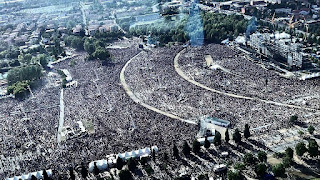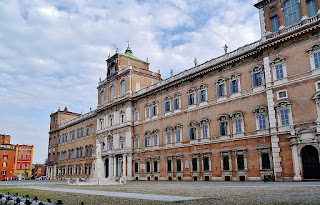Controversial rock star still performing
.jpg) |
| Vasco Rossi has been one of Italy's biggest stars for almost 40 years |
Rossi, who has attracted criticism for his lifestyle and for the sometimes controversial content of his songs, enjoys a huge following among fans of Italian rock music. An open-air concert he performed in Modena in 2017 sold 225,173 tickets, a record for tickets sold by any artist anywhere in the world.
Describing himself as a provocautore - a writer who provokes - he has written more than 250 songs, nine of which have been number one in the Italian singles charts, and made more than 30 albums, including five that were the best-selling album for the year of their release.
The enormous public enthusiasm for his work has not always been shared by the critics. Although his albums have won him many awards within his own sector of the music industry, when he appeared at the Sanremo Music Festival in 1982, the judging panel placed him bottom, reportedly in protest at the lyrics and his on-stage behaviour, which they thought was disrespectful to the competition.
Despite his success, Rossi has at times struggled with alcohol and drug addictions and depression yet has used the darker periods in his life as the inspiration for songs. Following his arrest and brief imprisonment for cocaine possession in the 1980s, he produced an album entitled Bollicine - Little Bubbles - that featured lyrics about drug use, attracting more opprobrium but at the same time helping secure his status as a rock icon.
 |
| Rossi in the 1970s, at the start of his career |
Instead of equipping himself for a career in finance or business, he worked as a DJ, setting up the Punta Club, a party venue, before teaming up with some friends to open Punta Radio, one of Italy’s first private radio stations. His own early recordings tended to get their first airing on Punta Radio.
His first EP was released in 1977, including the songs Jenny è pazza and Silvia, followed by his debut album the following year, and has brought out a new album almost every year since, an extraordinary output. It took a few years to achieve peak popularity, while the shock of his father’s death in 1979 from a stroke at the age of just 56 almost persuaded him to quit. But by the late 1980s his albums were selling in huge numbers and he had to move from traditional concert venues into stadiums such as the Stadio Giuseppe Meazza - better known as San Siro - in Milan, territory usually reserved for international superstars such as U2 and Madonna.
 |
| An aerial shot of the crowd of more than 225,000 fans who saw Rossi's 2017 concert in Modena |
He announced in 2011 that he was retiring from touring, yet was back on stage only two years later. In his career he has performed in more than 800 concerts, watched by more than 10 million fans. He has more dates planned this year.
Rossi has three children Davide and Lorenzo - both born in 1986 - and Luca, born in 1991, all by different partners. He married Luca’s mother, Laura Schmidt, in a low-key ceremony in Zocca in 2012.
 |
| Zocca occupies a hillside location around 45km (28 miles) southeast of Modena in Emilia-Romagna |
Vasco Rossi’s home village of Zocca in Emilia-Romagna can be found around 45km (28 miles) southeast of Modena and a similar distance southwest of Bologna. It sits on the eastern side of the mountain that divides the Panaro River Valley from the Reno and Samoggia Valleys. It enjoys a strategically favourable position, which was reflected in mediaeval history by the establishment of a number of castles in the area and more recently by its importance in World War Two as a stronghold of the Italian resistance movement. Zocca has a pleasant centre characterised by elegant shops and a number of interesting churches, including the neo-Romanesque chiesa del Sacro Cuore di Gesù and the Santuario della Verucchia, which has its origins in the 12th century. A music festival in Zocca was established by Rossi’s friend, Massimo Riva, and rock fans visit the area in large numbers in the summer months, attracted by a tour organised by the Visit Modena tourist office. A chestnut festival takes place every October.
 |
| The magnificent Baroque architecture of the Ducal Palace is one of the main attractions of Modena |
Modena, where Vasco Rossi set a world record for ticket sales for his 2017 concert at the Enzo Ferrari Park motor racing venue, is a city on the south side of the Po Valley in the Emilia-Romagna region It is known for its car industry, as Ferrari, De Tomaso, Lamborghini, Pagani and Maserati have all been located there. The city is also well known for producing balsamic vinegar, while operatic tenor Luciano Pavarotti and soprano Mirella Freni were both born in Modena. One of the main sights in Modena is the huge, baroque Ducal Palace, which was begun by Francesco I on the site of a former castle in 1635. His architect, Luigi Bartolomeo Avanzini, created a home for him that few European princes could match at the time. The palace is now home to the Italian national military academy. In the Galleria Estense, on the upper floor of the Palazzo dei Musei in Modena, the one-metre high bust of Francesco I d’Este, Duke of Modena, by Gian Lorenzo Bernini, still seems to be commanding the city.
Also on this day:
1497: Preacher Girolamo Savonarola’s ‘bonfire of the vanities’
1622: The birth of Vittoria delle Rovere, Grand Duchess of Tuscany
1878: The death of Pope Pius IX
1909: The birth of cavalry officer Amedeo Guillet
1941: The birth of pop singer Little Tony
.jpg)














.jpg)



